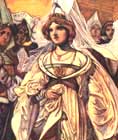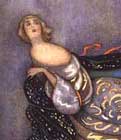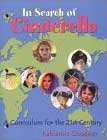
Cinderella:
345 Variants
by Marian
Roalfe Cox
SurLaLune's
Cinderella Area
SurLaLune Fairy Tales Main Page
309
Meier, Ernst, Deutsche Volksmärchen aus Schwaben. Stuttgart, 1852. No. XLVIII. Pp. 1645-74. (From Heubach.)
"THE YOUNG COUNTESS AND THE WATER-NYMPH."
ABSTRACT
Water-nymph promises to stand godmother to countess's child. Daughter born; all wait in church for water-nymph, who at length appears and gives child little basket with three eggs-- Countess dies; father marries again-- Ill-treated heroine (she is neglected by stepmother)-- Heroine plays by the lake; water- nymph amuses her-- Father's castle burnt down; he is reduced to poverty-- Godmother aid-- Menial heroine (scullion at castle)-- Heroine disguise (peasant's dress)-- Magic dresses (from two of the wishing-eggs)-- Meeting-place (ball) -- Twofold flight-- Love-sick young master--Recognition food contains ring given at ball-- Happy marriage-- Mother-in-law throws heroine's two daughters in lake, and accuses her of murder. Heroine shut up in red-hot oven. Third wishing-egg causes water-nymph to appear and cool fires. Heroine fetches her children from lake, where godmother has succoured them; father acknowledges them, and begs forgiveness of wife-- Villain Nemesis.
TABULATION
(1) A countess feeling ill, walks by the lake. She hears water-nymph talking, and addresses her, whereupon she comes forth and they converse. After this they often talk together, and become so intimate that water-nymph promises to stand godmother to countess's child. When daughter is born water-nymph is summoned to keep her promise. All are in attendance for the christening, except the godmother. They wait long, when at last the door opens, and in steps the water-nymph in a great white veil which is half wet. She holds child at font, and gives it, as baptismal present, a little basket with three eggs. These eggs must be taken great care of, as they may prove useful to child.-- (2) Not long after countess dies, father marries again, and step mother neglects child, giving it over to nursemaid, who allows it to play alone by the lake. Water-nymph comes to amuse child, and tells her many pretty stories. Child has happy life till, when fairly grown up, her father's castle is burnt down, and he becomes a poor man. Heroine escapes with egg-basket to godmother in the lake, and asks her advice. Godmother tells her that, having the three eggs, she is rich enough, for they can perform three wishes, however hard. But she must not expend wishes thoughtlessly, and always keep one for emergency.-- (3) She bids her go through forest and take service at large house. Heroine sets out. On the way she meets a peasant-girl called "Katterle", and exchanges clothes with her; then goes on alone through forest to castle, and inquires if a servant is wanted. At first they will not engage her, because she looks too young and too tender; but when she asks very little wages, and offers to do all the house-work and help cook, they at last take her. Her white hands get rough and brown, and her clothes ragged and dirty, so that she must keep away from best rooms. Seven years pass in this way.-- (4) Son of the house thinks of marrying, and gives grand ball, to which all lovely girls near are invited. Seeing them arrive in lovely dresses, heroine longs to go to ball, and remembers her three eggs. Having finished work, she wishes for lovely dress, which she dons and goes to ball. Son of the house is charmed, and, before she leaves, begs for her handkerchief; giving his own in exchange. She returns to her room and puts on rags. Everyone talks of lovely stranger at ball, and heroine listens attentively.-- (5) After four weeks young master gives second ball. Heroine makes use of second wish, and obtains dress covered with diamonds. Everyone is astounded. Young master declares his love for her, and wishes to wed her. Heroine says she fears that he will rue his words when he learns who she is. He protests he will love her best spite of anything. They exchange rings. She is to return in four weeks to marry him. Heroine escapes secretly. She hears all the girls talking about young master's lovely bride, but says nothing-- (6) Day arrives for wedding-ball. Heroine remembers with alarm that she has only one wish left, and she must keep this for emergency. So she cannot attend ball, and bridegroom is very unhappy, and falls ill.-- (7) No doctor can ease him; he thinks only of his bride, and nearly dies of grief. Heroine, learning this from cook whom she assists, reproaches herself for not having spent third wish in going to ball. She thinks day and night how to help lover. Doctor orders soup for invalid, and heroine begs cook to let her make it. This is at length permitted. Heroine puts her betrothal ring in soup, which cook takes to young master. He enjoys all the soup, then sees ring and sends for cook, who is very distressed, knowing nothing of ring, and confesses at last that kitchen-maid prepared soup. Heroine is fetched, young master calls her an ugly, dirty thing, and asks how she got ring. She answers humbly that the kind master gave it her himself. He reviles her, and orders her out of the room. Heroine washes herself, puts on dress of diamonds, and taking with her first ball-dress, and the handkerchief young master gave her, goes again to his room. Servant is standing on guard at the door, and, seeing the true bride, wishes to be the first to tell young mister, and in his haste falls downstairs and breaks a leg. Another servant, standing below, is blinded by the glitter of the diamonds.-- (8) Heroine appears before young master, who recognises her, and is instantly well. Heroine says, "This is the ugly, dirty kitchen maid whom you drove away, and who said you would not marry her when you knew who she was." She relates everything, and shows first ball-dress and handkerchief. He begs her forgiveness, and they are married. His mother is indignant at his marrying kitchen-maid.-- (9) Heroine has daughter; mother-in-law takes it away and throws it in lake.1 She does the same with heroine's second daughter, and tells son that his wife is a murderess.-- (10) He orders wife to be burnt. She is shut up, and the great oven made red hot. When she can no longer bear heat, heroine remembers third wish, and wishes for godmother, the water-nymph. She appears instantly, cools everything, and opens room. Tells heroine that she has rescued her children thrown into lake, and that she will place them to-day, with written paper, on shore of lake. Thence heroine must fetch them.-- (11) When the two daughters, both very beautiful, come to castle, father recognises them as his own children, realises crime of mother-in-law, and begs forgiveness of wife. Wicked mother is punished, and the rest live happily. Heroine rewards those who were her fellow-servants, and especially the cook who allowed her to make the soup.
NOTES
Note 52
(P. 320.) Compare No. 100, in which
the stepmother throws the heroine's children into a pond. The incident
recurs in Arnason, pp. 370, 411, 413, 428. In each of these stories (except
No. 100) the heroine is calumniated and cast forth; but her life is spared,
and her children, who have been rescued, are restored to her. She is eventually
reunited to her husband. See the references given in note
20.
Return to place in text.
Cox, Marian Roalfe. Cinderella: Three Hundred and Forty-five Variants of Cinderella, Catskin, and Cap O' Rushes, abstracted and tabulated. London: David Nutt for the Folklore Society, 1893.
While the original text of this book is out of copyright, the special formatting and compilation available on SurLaLune Fairy Tales is copyrighted. Be aware that while the original content has been honored, page numbering, footnote numbering, redesigned charts, links, and other aspects are unique to this site's version of the text. Use at your own risk. For private and fair use educational purposes only.
©Heidi
Anne Heiner, SurLaLune Fairy Tales
E-mail: surlalune@aol.com
Page last updated February 1, 2006
www.surlalunefairytales.com










